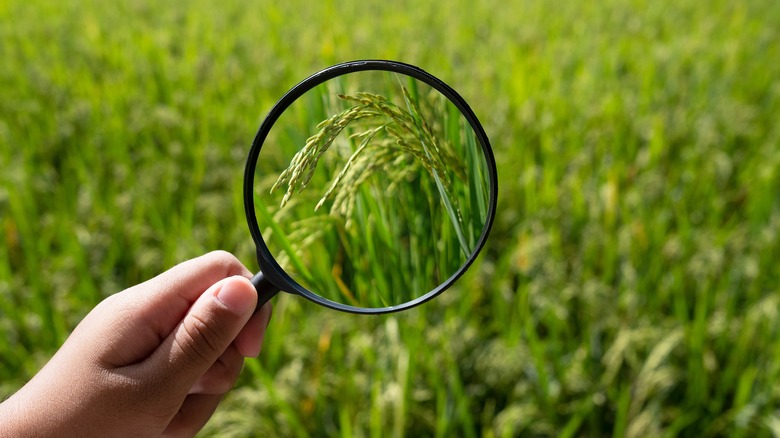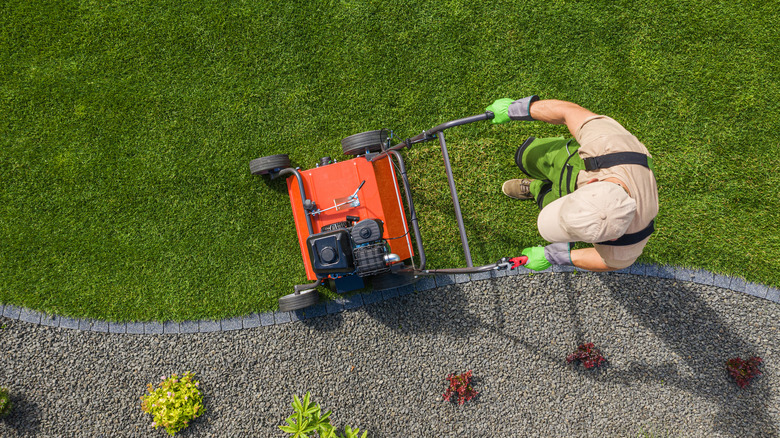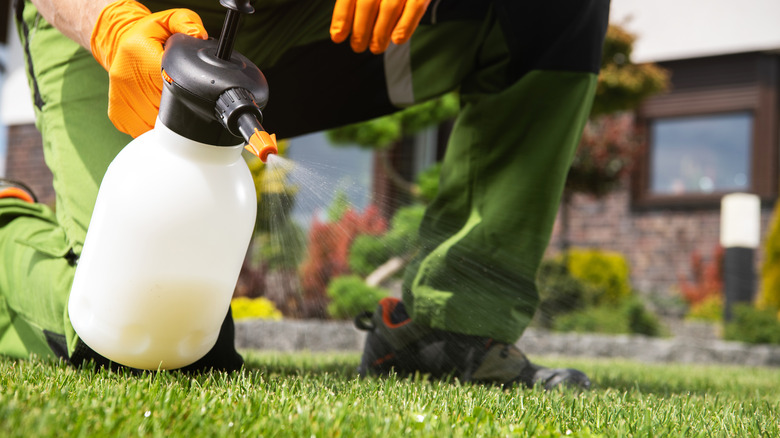How To Keep Your Lawn Green And Lush, According To HGTV's Matt Blashaw
Can you guess America's most irrigated crop? You might assume that it's wheat, rye, or corn, but our nation's most watered plant is actually much more familiar. According to Grist, the answer might be right outside your front door. Americans value their vast, green lawns so much that we spend more than 36 billion dollars on lawn care every year, and keeping a lawn alive can account for as much as 50 to 70% of a home's water usage. That's a lot of watering, plucking, seeding, mowing, and grooming that goes into maintaining a flawless and picnic blanket-worthy lawn, but sometimes it seems like no matter how hard you work in your yard, the patchy brown grass won't seem to budge.
If you're tired of despairing over a dull, crunchy lawn, it's time to heed some advice from the experts. Matt Blashaw, star of the HGTV series Professional Grade, is a pro at helping people achieve the home improvement transformations of their dreams, especially when it comes to the exterior lawn and garden spaces. Before you throw in the towel, check out Blashaw's tips for fostering lusher, fuller grass that will turn the whole neighborhood green with envy.
Get to know your grass
Kentucky bluegrass, buffalo grass, fine fescue, and St. Augustine are some popular options, but there are actually over 12,000 species of grass, notes Leafy Place. Whether you're planting anew or overseeding your lawn, it's vital to choose the right type of grass. Some species will thrive better in wet, acidic soil, while others are built to withstand high heat and dry, sandy conditions. Matt Blashaw said, "the type you choose depends on your specific area." Researching the soil requirements of your unique species is key to long-term success, so before purchasing any seeds or sprouts, Blashaw advised, "take a little sample of your soil to the local nursery where they will be able to evaluate the pH level and give you the right soil amendments to add before installing" (via Homes & Gardens.)
After you've got your soil sorted out, you'll need to adapt your lawn care habits to suit your lawn. "Your lawn will thrive in the environment it was meant to be in," said Blashaw, noting that it's very hard to force grass to grow in the wrong setting. "I see people all over the country try to grow lawns under heavily shaded trees or under trees with very dense root systems towards the top of the soil," he said, "no matter how hard you try the grass will simply not grow."
Big moves make a difference
You don't have to painstakingly tend to your grass to achieve a lush, green lawn. Keeping up with regular maintenance is necessary, but putting in some effort at just the right time will set you up for long-term success. "The best thing to do is scalp (cut very close) the lawn once or twice a year," Matt Blashaw advised, "a good tip is to run the lawn mower first at a very low depth and then use a stiff rake afterward to bring up even more thatch. Then run the lawn mower over once again to pick up what you loosened" (via Homes and Gardens.)
Raking up lawn clippings is one often overlooked way to encourage sunshine and nutrients, but if your lawn needs a total boost, consider aerating the soil. Aerating sounds complicated, but all it entails is punching holes in the earth to encourage airflow and nutrient absorption. Blashaw remarked that you don't even need fancy equipment to pull it off, stating, "You could go down and rent an aerating machine from the local rental shop or you can just put some heavy spikes on your shoes while mowing. I bought some aerating spikes online and wear them while I mow." When combined with a good watering and fertilizing routine, Blashaw insists that these occasional chores can really help your lawn take off.
Little habits matter too
Anyone will a lush, green lawn will tell you it requires constant work. Watering, fertilizing, weed-pulling, and overseeding are just some of the chores that come with a gorgeous lawn. Watering your lawn regularly may seem like a no-brainer, but many people forget to water according to the species needs. For example, fescue grass prefers wet and cool environments, while Bermuda grass is perfectly happy going for a few weeks without water, explains Lawn Chick. It's best to develop a routine that can still ebb and flow with the weather, such as hand-watering every week, so that your sprinkler system won't flood the roots during rainy seasons or neglect dry areas in the summer.
The work isn't over just because you've discovered a perfect watering schedule, according to Matt Blashaw. He advised homeowners and gardeners to pay attention to the creepy crawlies that could be ruining their lawns, stating, "There are hundreds of insects that can leave brown spots on a lawn in a matter of weeks and create irreversible damage if not properly taken care of" (via Homes & Gardens.) To combat pests, Blashaw recommended a using broad-spectrum and versatile insecticide, calling it "a game-changer and quite possibly your lawn changer."



